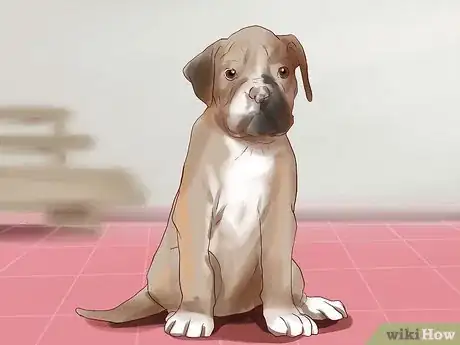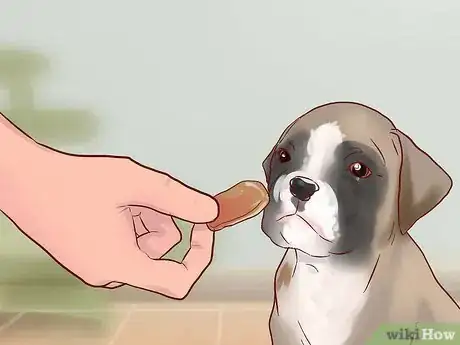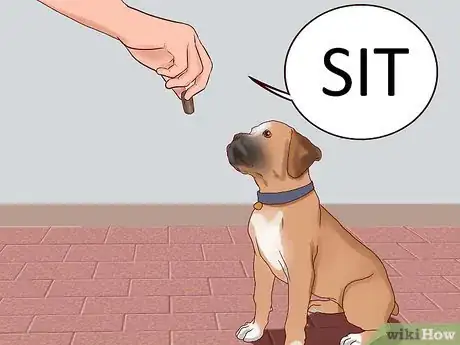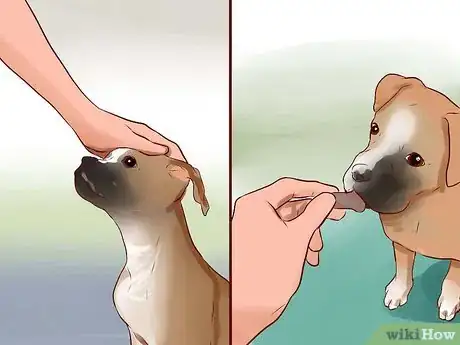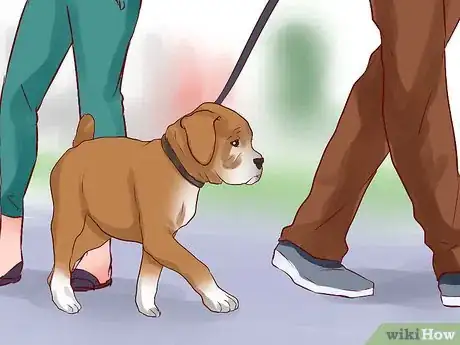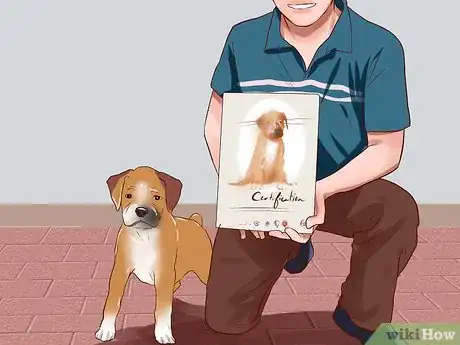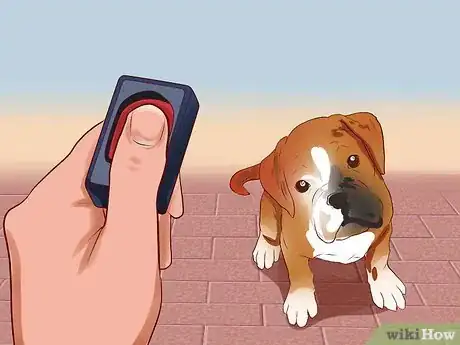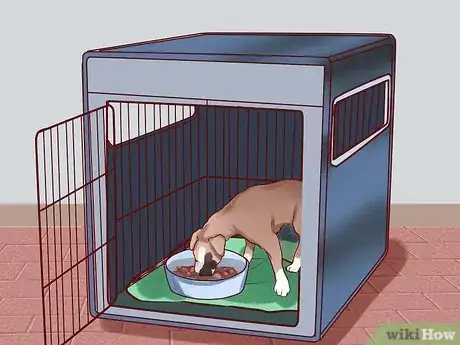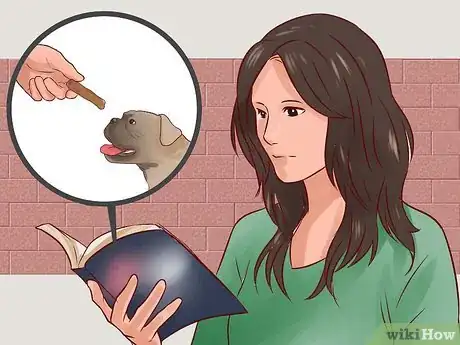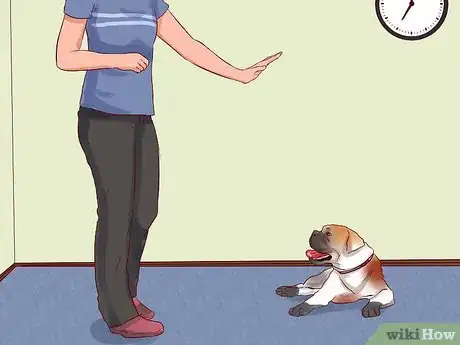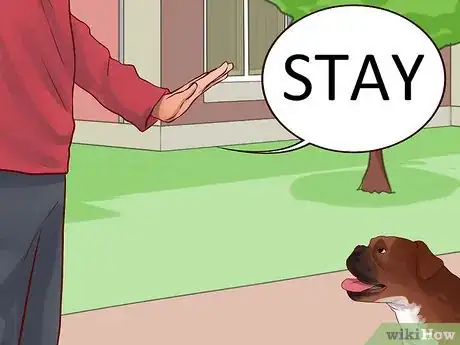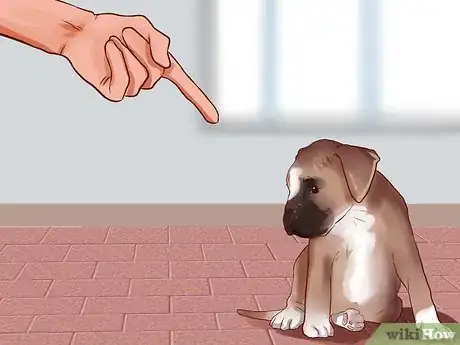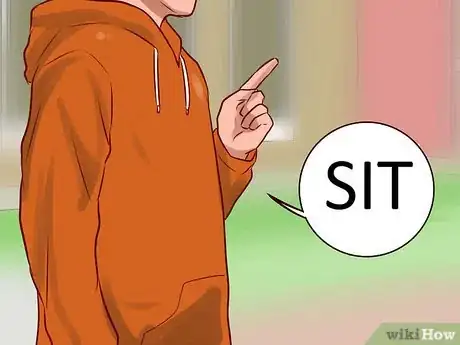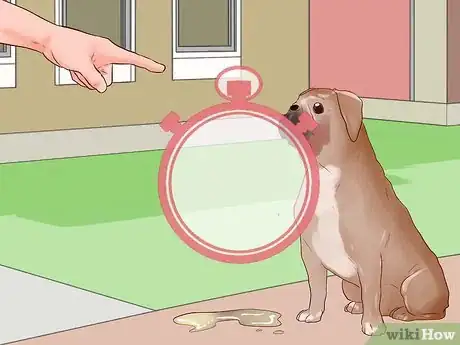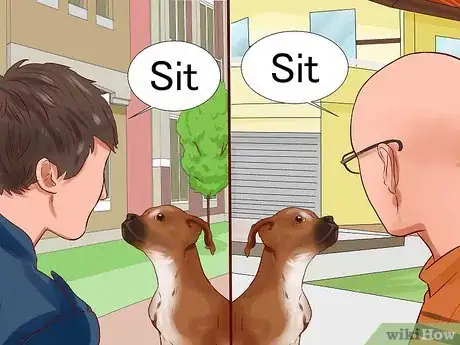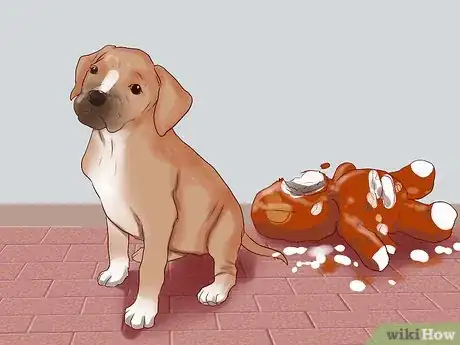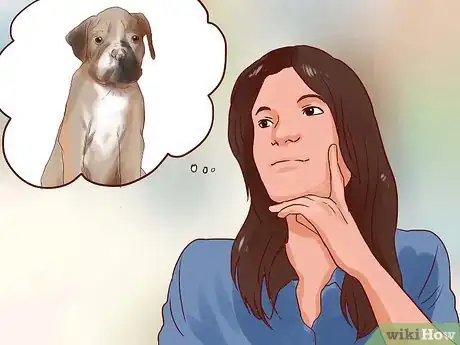This article was co-authored by Brian Bourquin, DVM. Brian Bourquin, better known as “Dr. B” to his clients, is a Veterinarian and the Owner of Boston Veterinary Clinic, a pet health care and veterinary clinic with three locations, South End/Bay Village, the Seaport, and Brookline, Massachusetts. Boston Veterinary Clinic specializes in primary veterinary care, including wellness and preventative care, sick and emergency care, soft-tissue surgery, dentistry. The clinic also provides specialty services in behavior, nutrition, and alternative pain management therapies using acupuncture, and therapeutic laser treatments. Boston Veterinary Clinic is an AAHA (American Animal Hospital Association) accredited hospital and Boston’s first Fear Free Certified Clinic. Brian has over 19 years of veterinary experience and earned his Doctor of Veterinary Medicine from Cornell University.
There are 9 references cited in this article, which can be found at the bottom of the page.
wikiHow marks an article as reader-approved once it receives enough positive feedback. In this case, 93% of readers who voted found the article helpful, earning it our reader-approved status.
This article has been viewed 246,193 times.
The Boxer is a German breed that was created by crossing a Bullenbeisser, a little-known breed, and an English Bulldog. The Boxer is a loyal, intelligent, highly excitable breed. They are playful, curious and extremely energetic. These traits make it essential that anyone who adds a young one to their family be well-versed on how to train a Boxer puppy.
Steps
Doing Basic Training
-
1Begin training early. Boxer dogs are highly energetic but also intelligent animals. They will learn through through repetition, so it's important you begin issuing clear commands and cues early on, even when they're puppies.[1]
- For young puppies (8 to 12 weeks old), keep training sessions short but fun. For example, when you bring your new puppy home, take him to the toilet spot in the garden, and praise him when he uses it. It will be a coincidence at first, but it's never too young to tell him "Toilet time" when he happens to squat. Then lavish lots of praise on your dog. This will help your dog learn to connect that behavior with praise from the get-go and make him more likely to repeat it.[2]
- You can also start with simple commands such as "Sit". With a young pup, the training is a simple as spotting he's about to sit anyway, and when his hind leg hits the ground, saying "Sit" and making a bit of a fuss of him. He'll be perplexed at first, but soon he'll realize the link between the word and the action.
-
2Focus on rewards-based training. This method works by rewarding good behavior, while ignoring the bad. This capitalizes on the idea of using what motivates a Boxer puppy to train him: rewards of food and attention/affection. The idea is that the Boxer works hard to repeat the behavior which earned him a treat or a fuss. The unwanted behavior was ignored by you, the trainer, and in your dog's mind does not benefit him at all, is a waste of energy, and therefore is not worth repeating. Because Boxers like food and attention, this is the best way to train them.[3] [4]
- Punishment is not a part of this training technique. Never beat your dog. Beating or hitting dogs when they behave undesirably is not a useful training measure. Instead of learning from the punishment, your dog will instead become fearful of you, which ultimately defeats the training process since that is not the desired result.
- In the end, rewarding good behavior is more useful and constructive for training purposes than punishing bad behavior.
Advertisement -
3Use food rewards.[5] Appeal to your Boxer puppy's belly. Boxers are very food-oriented and motivated. Reward desirable behavior with food and you’re likely to get a repeat of that good behavior. Food treats should be small, such as Mini Zukes, Charlie Bears, Bil Jac or freeze-dried liver. Many dogs will even work for their regular dog kibble.
- Think about the giving of treats as a reward for the behavior you wish to encourage only as a starting measure. Treats should soon be replaced with praise as the reward, otherwise, the dog may become overweight or even obese.[6]
- Alternatively, you could also weigh out your dog's daily food allowance out and then set aside a small amount of the daily total for use as treats.[7] This helps prevent your Boxer from putting on weight with all the training you are doing.[8]
-
4Start with basic commands. Aim to give a command, and then give a reward immediately the action is carried out. This strengthens the link in the dog's mind between action and reward. Start with a basic command, such as "Sit," and work on that until your dog has it mastered.[9]
- Grab a treat and let the puppy sniff the treat in your hand so he knows it's there. Then hold the treat just above the pup's eye level, over the head, so he has to look up to keep it in view. Once he is looking for the treat, draw an arc over her head so that when he looks up to follow, his bottom naturally sinks down. As soon as he starts sitting, say give the command "Sit" and give the treat.
- Work up to other commands or tricks, such as "Lie down" and "Paw" (where he extends his paw to you. Rewards-based training is the best method to get your dog to understand and follow all kinds of commands and cues.
-
5Mix up the reward-giving. Once your dog is regularly repeating an action after he is issued a command, make the treat giving less predictable. Mix things up a little. Typically, a dog that gets a reward every time gets sloppy because the treats are too easy to come by. By skipping a reward, it sharpens up your dog's thinking and makes him wonder if he didn't sit fast enough or well enough. He will, therefore, work harder to please you. Eventually, you will reward every fourth or fifth command, so that he remains focused on earning a treat but without getting discouraged that they are too hard to earn.[10]
-
6Expand the training. Test your Boxer pup in different situations and add distractions. Once you have established basic commands (e.g. "Sit" and "Stay") in the quiet of your own yard, practice with distractions so the dog knows he must respond and learns to focus on you no matter what the distractions. Add noise, or another trainer, or even another animal. When you dog gets distracted and has troubling focusing, you need to temporarily interrupt his stream of thought by talking to or commanding him or by an action (such as stomping your foot).[11]
- Develop distraction techniques with treats in low distraction settings and at home. Always follow through with praise and treats. As you get more confident on your dog's ability to stay in control, increase the level of difficulty by walking around the block or near a dog park to work on his skills. Work up to busier areas once your puppy is consistently responding to commands like “leave it” or “watch me”.
- Work up slowly to added distraction and you will both gain confidence in your dog's ability to handle a crowd. This is key to creating a well-mannered dog that behaves well in situations where there are other people and animals.
-
7Enroll your puppy in an accredited obedience program. Local shelters, pet stores, and other organizations offer training programs at a low cost. Consider visiting one of the classes prior to enrolling to make sure that you agree with the type of training presented. You may also want to consider getting a professional trainer. A professional dog trainer, such as one from the Association of Professional Dog Trainers (APDT), is very knowledgeable about dogs and can help you learn basic handling skills. Overall, though it is an added expense, having professional training assistance is beneficial in the long run because it will help you and your energetic dog communicate effectively.[12]
- An important part of training is helping your Boxer to behave around other dogs, so try and attend a puppy class. Many veterinary clinics hold puppy classes, which are ideal for Boxers who need early socialization. All the attendees have received their first vaccination and are only allowed to attend if they are healthy. The benefit to the puppy is learning confidence and social skills around other young dogs.[13]
Using Specific Techniques
-
1House-train your dog. Choose a cue word or phrase to use when you take your dog outside, such as "Toilet time". If you use this word from the beginning, your Boxer puppy will learn to associate it with doing what he is supposed to do outside. When you bring the puppy home, take him straight outside to the toilet spot. The chances are he'll have a sniff around and toilet. When he does, say the cue phrase and then give him lots of praise or even a small treat. You are rewarding the good behavior (toileting in the desired spot) so that he starts to understand this is an easy way of getting a lovely fuss made about him.[14]
- When house-training a puppy, when possible take him outside every 20 to 30 minutes. This is to increase the chance of the puppy squatting as a matter of coincidence, and increases your chances of being there to give him lots of praise. Persistence at house-training is key.[15] [16]
- Watch your Boxer puppy carefully when he is inside. If he is walking in circles or sniffing the floor, he is likely getting ready to relieve himself. Take him outside immediately. If the puppy makes it outside, be sure to give him a treat and praise.
- When house-training, keep your Boxer confined to one room, so there are fewer distractions for him. In addition, if he does have an accident, you can find it and deodorize the spot. A dog allowed to roam the house may squat secretly and, if you don't find it, the smell will draw the puppy back to urinate there again.[17]
-
2Do clicker training. Clicker training gets the dog to associate the "click-clack" sound of a clicker (pressed by you) with a reward. The clever part of the clicker is that it can mark the precise moment that the desired action took place, hence building a strong link between the action and reward. Boxers are highly trainable because they are very food-motivated, which makes clicker training ideal for them.[18]
- Learn how to clicker train your dog. The clicker itself is a tiny plastic box held in the palm of your hand, with a metal tongue that you push quickly to make the sound. Eventually your dog will come to learn that clicks are always followed by treats, which is a very powerful incentive for Boxer puppies. One your dog makes this connection, you can use the click to mark the instant he performs the right behavior, such as sitting down. Over time, he will learn that sitting down when commanded gets him rewards.
-
3Consider crate training. Crate training your Boxer is a great idea. The idea is that the Boxer thinks of the crate as his den, a place where he's safe and can relax and sleep. Let the puppy discover the crate and want to go in voluntarily. The crate should be big enough for your puppy to turn all the way around, stand up, and lie down. Boxers do grow to be fairly large, so you may have to invest in a larger crate as your puppy gets bigger.[19]
- Learn how to crate train your dog or puppy. Make the crate an appealing place with a comfy dog bed, and scatter some treats inside. Give the puppy some meals in there but leave the door open. Once the puppy is happy to go to the crate, you can close the door for a few seconds, and open it again and if the puppy was quiet give her lots of praise.
- Note that a crate should never be used as a punishment or a prison, and should only ever be used in a positive way.
- Be aware of the following crate-time guidelines, and avoid leaving any dog in a crate for over five hours at a time (with the exception of overnight):
- Age 9 to 10 weeks: 30 to 60 minutes
- Age 11 to 14 weeks: 1 to 3 hours
- Age 15 to 16 weeks, 3 to 4 hours.
- Age 17+ weeks: 4 or more hours (but never more than six).
Becoming a Strong Trainer
-
1Research appropriate training methods. Before you start training your Boxer puppy—or, even better, before you get the puppy—read up on what kind of training is ideal for your breed. Check online, local libraries and local organizations. You can also ask your vet for advice. Remember, the more knowledgeable you are, the better you know how to react under different circumstances.
- Make sure as well that you have what you need to effectively train your dog. If you're planning to clicker train, get a clicker. If you're planning to crate train, get the right-sized crate. Also be sure to pick up an appropriate collar and leash for general training. A leash should be no more than five to six feet in length. The best leashes for training are leather. Always check your equipment to make sure it is in good order and not liable to snap or break.
-
2Find the right time and place for training. Training works best when you dedicate a couple of short sessions (10 to 15 minutes) twice a day to it. Try to train at times when the dog is not tired, but also not bursting with pent-up energy.[20]
- Consider expending your Boxer's energy before training sessions by allowing him 20 to 30 minutes of high-intensity physical activity. This will enable him to better focus on training.[21]
- A good time to choose to train a dog is just before a meal, so the dog will be very keen to work to earn those tasty treats.
- Try to train the dog in a place where there are few distractions, so that your Boxer puppy can focus his attention on you. This means avoiding places with other animals or people. Always begin training in your home or yard and build up to environments with more distractions (e.g., other dogs and more people).
-
3Be specific. Your commands need to be simple, short, clear and consistent. "No", "Drop", "Wait", "Stop," and "Fetch" are strong, simple, and direct. Don't lecture your dog; they're not human so they don't process language in the same way. Phrases like "I've told you not to do that" or "Please stop chewing on the table" will not work as they are too complicated.[22]
- Experts believe that a given dog registers the first part of the word as the most important, so longer commands such as "Sit Fido if you want a treat" are liable to confuse him. Just say the word "Sit" instead. In other words, for commands, choose words that are short and avoid long sentences
-
4Be firm and in control. In general, shouting at any dog is ineffective. This is especially true for Boxers who are hyper breed by nature. Use a firm but pleasant and upbeat voice when instructing your dog; don't yell or lose control. Dogs are very intuitive and will be able to sense your frustration and may react in kind. The tone of voice matters, especially since, again, dogs don't process language in the same way that humans do. So how you say something may mean as much if not more than what you say.[23]
- Boxers are playful by nature, and a light, breezy tone will not suffice; he will think you are just playing with him if you are not firm enough.
-
5Use hand gestures. Try using hand gestures at the same time as you issue verbal commands. For example, raise your hand at the same time as saying "Sit". Dog behaviorists believe that dogs look for multiple clues as to what we want them to do, which includes the command word, tone of voice, and body language.[24]
-
6Be timely and repetitive in your responses and commands. Admonishing a Boxer puppy too long after the incident is ineffective. If you need to admonish or correct your dog, it needs to be done during or within a few seconds of the act. Dogs will have forgotten the event within seconds of its occurrence, so it's key to address the behavior immediately in order to facilitate the retraining process.
-
7Be consistent. Always be consistent in your commands and desires of the dog. This helps your dog to understand what is expected. Don't forget to enforce training when you are out and about, so that your dog doesn't just thinking that "Sit" and "Stay" are things he has to do in the yard or house. By enforcing commands in public places it helps your Boxers to understand he must obey under all circumstances.[27]
- Consistency is key to making good behaviors routine and normal and thus turns your dog into a well-trained and behaved pet! Leave no room for doubt about what is acceptable behavior for your Boxer puppy. If he is not allowed on the furniture, be consistent. Boxers won't understand the concept of "sometimes"; they are either permitted to lie on the couch or they are not.
- If you live with other people, make sure that everyone in the house is on board with the training program. and that everyone uses the same commands. Using different words for the same action will confuse the dog, disrupt the training already done, and ultimately delay progress.
Understanding Boxers
-
1Remember that dogs weren't born trained. Keep in mind that your puppy wasn't born automatically knowing the rules of living in a human world. When your boxer puppy gets overexcited or misbehaves, it isn't because he is a fundamentally bad dog, but because he doesn't know any better. It's your job to teach him new behaviors that appropriate for coexisting and living with other animals and humans as well.
-
2Learn about the Boxer breed. Doing so will help you understand your new Boxer puppy while training him. Boxer dogs are a delight but they're also exuberant clowns that have a lot of energy and need plenty of stimulation, including lots of playtime and walks. This can make an unruly Boxer a bit of a pain to be around as he may pounce on you, almost cat-like, to get your attention, which for a 60–70 pounds (27–32 kg) dog can be quite painful. Also, the poorly trained Boxer may insist you play when he wants to, which again can be a nuisance if you want to quietly sit and watch TV.[28]
- Boxers by nature are loyal to humans, they generally get along with other pets in the household, and they tend to like children, usually playing gently when appropriate. Build on and reward these positive traits when training your puppy.
- Also bear in mind that Boxers have a reputation for taking up to three years to mature mentally, and can remain in a puppyish state until then, which for a big dog can be problematic if he wants to jump, pounce, paw, and dig at you. Luckily, good training can help settle your dog down.[29]
- It's important to note as well that although Boxer dogs as a breed may share some general characteristics, just as people have different personalities, so too do Boxer dogs. Though the breed tends to be energetic and hyper, it's also possible that your puppy may be shy or more relaxed.
-
3Treat Boxers in a manner that befits their breed. You need to understand what they want and need in order to train them. Boxers are extremely intelligent but sometimes hide it well behind their boisterous facade. They like people and are eager to please them, making Boxers an ideal breed for reward-based training, which relies on rewarding good behavior, while ignoring behavior. In other words, mobilize these inner traits of the breed in the training process; indeed, doing this is key to successful training.[30]
- Keep in mind that giving Boxer puppies what they need will help ensure that they don't engage in "bad behaviors". For example, Boxers need to play and be thoroughly walked. If you don't do this, they often become bored and destructive. Increased physical activity helps a dog stay healthy and also tires him out. Keep your dog active (and not destructive) by playing fetch and going on substantial walks at least twice a day.
Expert Q&A
-
QuestionHow do you train a Boxer puppy to not bite?
 Pippa Elliott, MRCVSDr. Elliott, BVMS, MRCVS is a veterinarian with over 30 years of experience in veterinary surgery and companion animal practice. She graduated from the University of Glasgow in 1987 with a degree in veterinary medicine and surgery. She has worked at the same animal clinic in her hometown for over 20 years.
Pippa Elliott, MRCVSDr. Elliott, BVMS, MRCVS is a veterinarian with over 30 years of experience in veterinary surgery and companion animal practice. She graduated from the University of Glasgow in 1987 with a degree in veterinary medicine and surgery. She has worked at the same animal clinic in her hometown for over 20 years.
Veterinarian Boxer puppies are full of energy and may bite from excitement more than malice. When the puppy nips, pretend to cry and leave the room. If he learns the game ends when he nips, he'll soon control himself so the play carries on.
Boxer puppies are full of energy and may bite from excitement more than malice. When the puppy nips, pretend to cry and leave the room. If he learns the game ends when he nips, he'll soon control himself so the play carries on. -
QuestionHow do I potty train my Boxer puppy?
 Pippa Elliott, MRCVSDr. Elliott, BVMS, MRCVS is a veterinarian with over 30 years of experience in veterinary surgery and companion animal practice. She graduated from the University of Glasgow in 1987 with a degree in veterinary medicine and surgery. She has worked at the same animal clinic in her hometown for over 20 years.
Pippa Elliott, MRCVSDr. Elliott, BVMS, MRCVS is a veterinarian with over 30 years of experience in veterinary surgery and companion animal practice. She graduated from the University of Glasgow in 1987 with a degree in veterinary medicine and surgery. She has worked at the same animal clinic in her hometown for over 20 years.
Veterinarian The quickest method is to use crate training and supervise the pup at all times. Pop the pup outside every 30 minutes during the day, stay with him and give lots of praise when he toilets in the right spot. Use the crate when you can't be with him indoors, to prevent him from having accidents.
The quickest method is to use crate training and supervise the pup at all times. Pop the pup outside every 30 minutes during the day, stay with him and give lots of praise when he toilets in the right spot. Use the crate when you can't be with him indoors, to prevent him from having accidents. -
QuestionHow do you discipline a Boxer?
 Pippa Elliott, MRCVSDr. Elliott, BVMS, MRCVS is a veterinarian with over 30 years of experience in veterinary surgery and companion animal practice. She graduated from the University of Glasgow in 1987 with a degree in veterinary medicine and surgery. She has worked at the same animal clinic in her hometown for over 20 years.
Pippa Elliott, MRCVSDr. Elliott, BVMS, MRCVS is a veterinarian with over 30 years of experience in veterinary surgery and companion animal practice. She graduated from the University of Glasgow in 1987 with a degree in veterinary medicine and surgery. She has worked at the same animal clinic in her hometown for over 20 years.
Veterinarian Never shout at or hit a Boxer dog. Apply the rules consistently, and reward his good behavior. If he's naughty, then a short sharp "No" is sufficient, followed by luring him to do the right action. Alternatively, withdraw your attention and leave the room, so that further bad behavior isn't rewarded.
Never shout at or hit a Boxer dog. Apply the rules consistently, and reward his good behavior. If he's naughty, then a short sharp "No" is sufficient, followed by luring him to do the right action. Alternatively, withdraw your attention and leave the room, so that further bad behavior isn't rewarded.
References
- ↑ https://petcareeducation.com/boxer-training/
- ↑ The Happy Puppy Handbook. Pippa Mattinson. Publisher: Ebury Press
- ↑ The Happy Puppy Handbook. Pippa Mattinson. Publisher: Ebury Press
- ↑ Don't Shoot the Dog. Karen Pryor. Publisher Ringpress Books
- ↑ Brian Bourquin, DVM. Veterinarian. Expert Interview. 20 December 2019.
- ↑ The Happy Puppy Handbook. Pippa Mattinson. Publisher: Ebury Press
- ↑ Brian Bourquin, DVM. Veterinarian. Expert Interview. 20 December 2019.
- ↑ The Happy Puppy Handbook. Pippa Mattinson. Publisher: Ebury Press
- ↑ Don't Shoot the Dog. Karen Pryor. Publisher Ringpress Books
- ↑ Don't Shoot the Dog. Karen Pryor. Publisher Ringpress Books
- ↑ Don't Shoot the Dog. Karen Pryor. Publisher: Ringpress Books
- ↑ https://www.aspca.org/pet-care/virtual-pet-behaviorist/finding-professional-help
- ↑ http://dogtime.com/dog-breeds/boxer
- ↑ The Happy Puppy Handbook. Pippa Mattinson. Publisher: Ebury Press
- ↑ http://dogtime.com/dog-breeds/boxer
- ↑ The Happy Puppy Handbook. Pippa Mattinson. Publisher: Ebury Press
- ↑ The Happy Puppy Handbook. Pippa Mattinson. Publisher: Ebury Press
- ↑ https://www.aspca.org/pet-care/virtual-pet-behaviorist/clicker-training-your-pet
- ↑ http://dogtime.com/dog-breeds/boxer
- ↑ Don't Shoot the Dog. Karen Pryor. Publisher: Ringpress Books
- ↑ https://petcareeducation.com/boxer-training/
- ↑ In Defence of Dogs. John Bradshaw. Publisher: Penguin
- ↑ In Defence of Dogs. John Bradshaw. Publisher: Penguin
- ↑ In Defence of Dogs. John Bradshaw. Publisher: Penguin
- ↑ http://dogtime.com/dog-breeds/boxer
- ↑ https://petcareeducation.com/boxer-training/
- ↑ http://dogtime.com/dog-breeds/boxer
- ↑ http://dogtime.com/dog-breeds/boxer
- ↑ http://dogtime.com/dog-breeds/boxer
- ↑ The Happy Puppy Handbook. Pippa Mattinson. Publisher: Ebury Press
About This Article
To train a boxer puppy, start by teaching your dog simple verbal commands like "Sit" and "Stay." Then, provide a reward, such as a tasty treat, immediately after the action is carried out to reinforce the behavior. Use a firm but pleasant voice and remember to be clear and consistent to prevent any confusion. Also, aim for 10-15 minute training sessions each day and avoid long training sessions, since these tend to be ineffective. When instructing your dog, don't yell or lose control, since boxers are very intuitive! For more tips on understanding the boxer breed's personality, read on!
